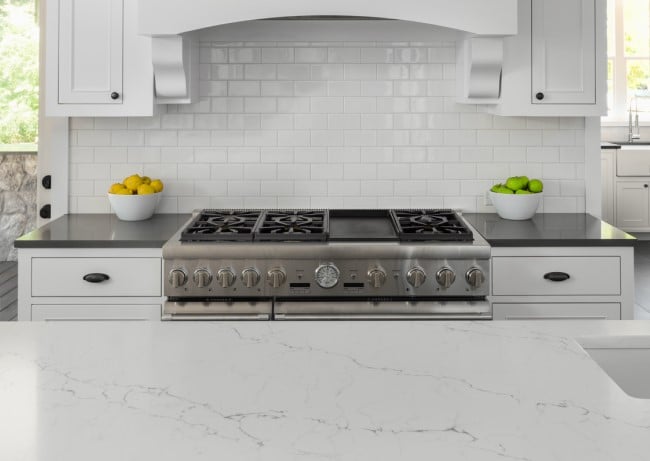
Read about some countertop care and maintenance tips in this joint-venture guest post from our friends at countertopspecialty.com!
The kitchen is the heart and hub of the home. It’s where most activity occurs and kitchen countertops get a ton of wear and tear whether you and your family love to cook or not. Therefore, when choosing a new countertop material, one of the most important factors to consider is cleaning and maintenance.
Below, we’ve reviewed five popular types of countertop materials and what it takes to clean and maintain each of them. The cleaning and maintenance demands of a particular surface will certainly color your long-term experience and enjoyment of your countertops and kitchen. It pays to use this information wisely and choose the countertop most suited to your needs and lifestyle. Trust us… You’ll be exceptionally glad you took the time to do so.
1. Granite Countertops
Sealing
Sealing is recommended for any type of granite, despite color. The reasoning is that essentially all stone is porous, so sealing is an important step in protecting your stone from foreign substances. It is true that some stone is more dense than other stone, including certain granite varieties. The main difference in these types of materials is how frequently they’ll need to be resealed.
You’ll learn:
● How many coats of sealer to apply ● When you may need to re-apply a sealer ● If the stone is sensitive to acids or possibly other chemicals
Keep in mind that if you do require a granite sealer, it will usually only be necessary once every 1 to 3 years.
Everyday Cleaning and Maintenance
To keep your granite countertops looking fresh and new, always clean spills immediately when they happen with a soft cloth or sponge. Potentially, liquids like fruit juice, coffee, oils, and wine could cause stains, but stains are generally less of a problem after sealing or on a dark granite.
If properly cared for on a day-to-day basis, you shouldn’t have to worry too much about stains once granite has been sealed; however, as mentioned, staining is still possible. If any of the liquids listed above, or even harsh cleaning agents are left on the surface for a prolonged period, or if the stone is exposed to those products frequently, eventually the sealer can be broken down and leave the stone more susceptible to stains.
Also, never use glass cleaners, bleach, degreasers, lemon juice, ammonia, tile or grout cleaner, or vinegar on granite as a regular cleaner. These may not instantly cause damage, but repeated use degrades the sealer and may dull the finish which is expensive to repair.
It’s best to use a quality granite & marble cleaning spray. Dish soap is commonly suggested and it won’t harm granite, however, it will form a film that dulls the finish over time.
Scratching is extremely rare on granite and hot pans won’t bother it. But still, it’s smart to use cutting boards and trivets on your granite countertops.
2. Marble
Marble is a beautiful choice for countertops. However, marble has one particular issue that can be troublesome in the kitchen. This also includes travertine and limestone which are sisters to marble and have the same cleaning demands.
Sealing
Polished marble still should be sealed even though the polishing process helps to close the pores. The polish may help fill pores on the surface of the stone, but they do not seal all of the pores. Sealing is partiularily important on honed marble to prevent stains.

It’s a myth that marble stains easily. You always hear and read this, but it’s incorrect. Marble “etches” easily and these etch marks are confused for stains. Etching is the issue you want to understand if considering marble for a kitchen countertop.
Etching occurs when a caustic cleaning product or acidic foods and drinks (like coffee, juice or vinegar) react with the marble surface. This causes corrosion of the surface leaving a dull spot, spray mark, or glass ring.
Therefore, wipe up spills quickly, don’t use common household cleaners as most will damage marble, and minimize contact with foods and drinks by using cutting boards, trivets, and coasters.
Keep in mind that the reason for sealing marble is to prevent staining from substances absorbing. But etching is completely different. It’s like a chemical burn. Sealers will not stop etching.
This etch remover / marble polish will easily repair etch marks on polished marble, however, etching will periodically occur since it is impossible to prevent all contact with acidic foods on kitchen countertops. For some, this is no big deal. Repairs are simple enough. For others, it’s a constant source of frustration.
Note that marble etching isn’t typically an issue on floors or in bathrooms where food exposure is far less than on a kitchen countertop. Plus using products specific for cleaning marble removes the possibility of damage from using the wrong cleaner. So, marble can be low-maintenance once you understand the do’s and don’ts.
3. Quartz Countertops
Quartz countertops are beautiful, sophisticated, and high-quality. This man-made surface is very durable and offers simple, but not carefree, cleaning and maintenance.
Sealing
Quartz countertops do not require sealing. This is certainly a benefit, however, it does not mean that quartz countertops cannot be stained or discolored. This fact is commonly unclear to consumers.
Everyday Cleaning and Maintenance
Quartz is very difficult to stain and will generally resist staining and damage from most foods and products. However, some foods and drinks and several types of cleaning products may discolor the surface. White quartz is particularly vulnerable.
Unlike granite where most stains can be removed, staining or discoloration of quartz countertops is usually permanent. The risk of stains occurring is very low, and shouldn’t deter you from choosing quartz. But it’s important to know it can happen to ensure you maintain your countertops in top condition.
Quartz will not scratch. However, hot pans should be placed on trivets as excessive heat can mar the surface.
To keep your quartz countertops clean and shiny, avoid using soap as this will create a residue. The smart tip is to use a granite & marble cleaner. Quartz surfaces are 93% natural stone after all. This will also eliminate possible permanent discoloration from using the wrong cleaning product.
4. Soapstone
Soapstone is very beautiful if you’re looking for a gray or black countertop. It is one of the most durable countertop materials on the market. It stands up well to heat and doesn’t etch or stain. However, it can be scratched. When purchasing soapstone, remember that the more solid the color (non-veined varieties), the more durable and scratch-resistant it will be.
Sealing
Soapstone comes out of the quarry with a light gray color. Sometimes it can be a bit green. Over time, the soapstone oxidizes and darkens. Sealing or applying mineral oil to soapstone is a common practice to help bring out the beautiful dark luster that is characteristic of this material. To maintain this sleek, “wet” look, you’ll want to reseal or reapply mineral oil as needed.
For interior use, its recommended sealing soapstone slabs with Alberene Dry Wax. This is a 100% natural product made from Beeswax, Olive Oil and Carnauba. For exterior, its recommended to seal soapstone with Seal and Enhance. Both interior and exterior sealers will need to be reapplied in 4 to 6 months or as needed. Both of these sealers will darken the soapstone so please apply to a scrap piece from your installation before sealing the entire job.
Everyday Cleaning and Maintenance
Staining is almost impossible with soapstone. Still, as a rule with any surface, it’s best to always use coasters for drinks and clean up spills immediately with a soft cloth or sponge. Similarly, always use cutting boards as scratching is possible with this material.
If you do notice scratches, the good news is that these can be easily sanded away. Many soapstone countertop owners do a complete sanding of their soapstone countertops once every few years followed by a mineral oil application. This keeps them looking brand new.
5. Porcelain Tile or Ceramic Tile
Porcelain tile and ceramic tile are a budget-friendly yet still durable countertop option. Porcelain and ceramic tile are manufactured in essentially the same fashion and act the same in terms of stain and damage-resistance. The main difference is in hardness — porcelain is nearly as hard as stone and thus harder than ceramic. It’s also more expensive than ceramic.
Both materials offer a wide range of styles, thicknesses, shapes, and colors. This countertop choice is relatively easy to clean and maintain. The grout in between the tiles is the primary cleaning issue.
Sealing
When either porcelain tile or ceramic tile is glazed, it does not require sealing. On the other hand, an unglazed and polished porcelain may need sealing. Opposite of marble, the polishing process opens the pores of porcelain. Consult with the tile manufacturer or test a sample tile for absorption to learn if a sealer should be applied.
Everyday Cleaning and Maintenance
Staining is rarely a problem with porcelain or ceramic tile. However, wiping up spills quickly is advised as grout can stain. Common household cleaners can be used on both ceramic and porcelain countertops.
Always using cutting boards and trivets with hot pots and pans on these surfaces will help avoid scratching or chipping.
Chipping and cracking do sometimes happen with tiles. Many porcelain tiles have “through body” color so chips are not as noticeable and potentially easier to repair than chipped ceramic tiles. It’s a good idea to keep extra tiles on hand in case one or two need replacing. If grout becomes discolored, use a stiff nylon brush and grout cleaner.
The Best Kitchen Countertop for You
Much of home life is lived in the kitchen. Your kitchen countertops will get their fair share of use and abuse. To make the best choice look beyond colors and patterns and consider your lifestyle, family habits, and the particular maintenance needs of each countertop material. Most types of countertops offer enough design options to suit any style, so it comes down to the often overlooked maintenance requirements that ultimately determine your enjoyment of the surface for years to come.





